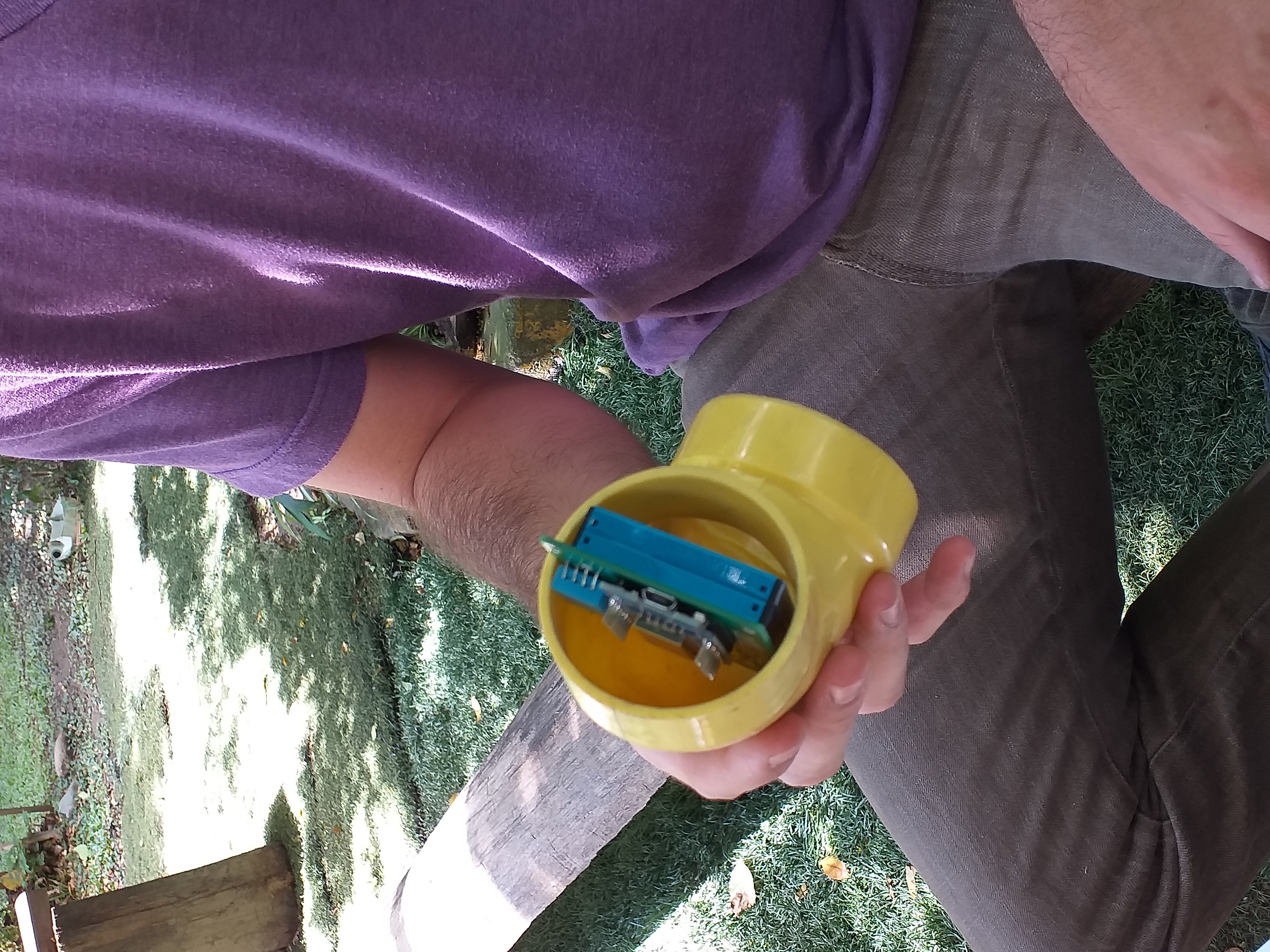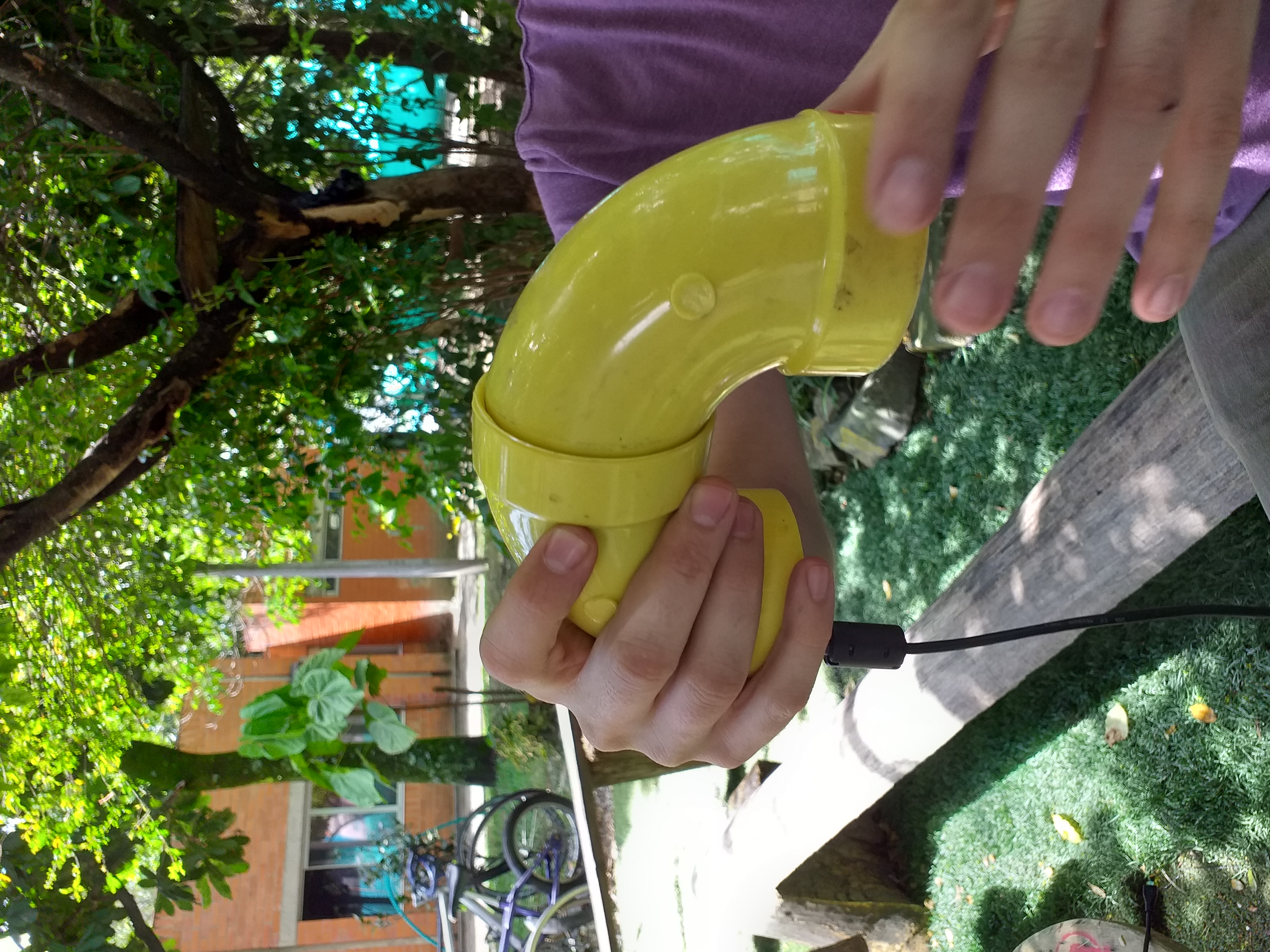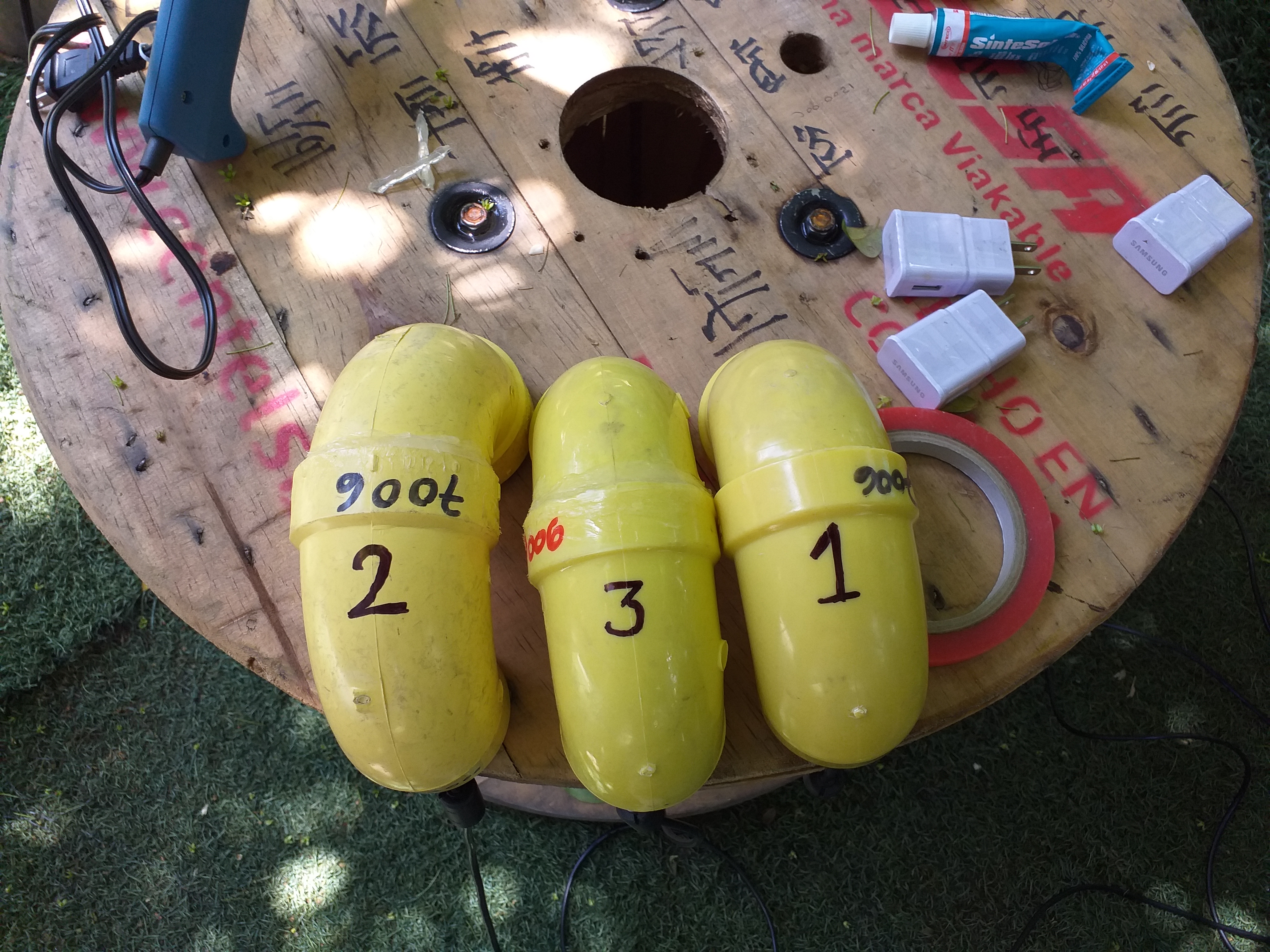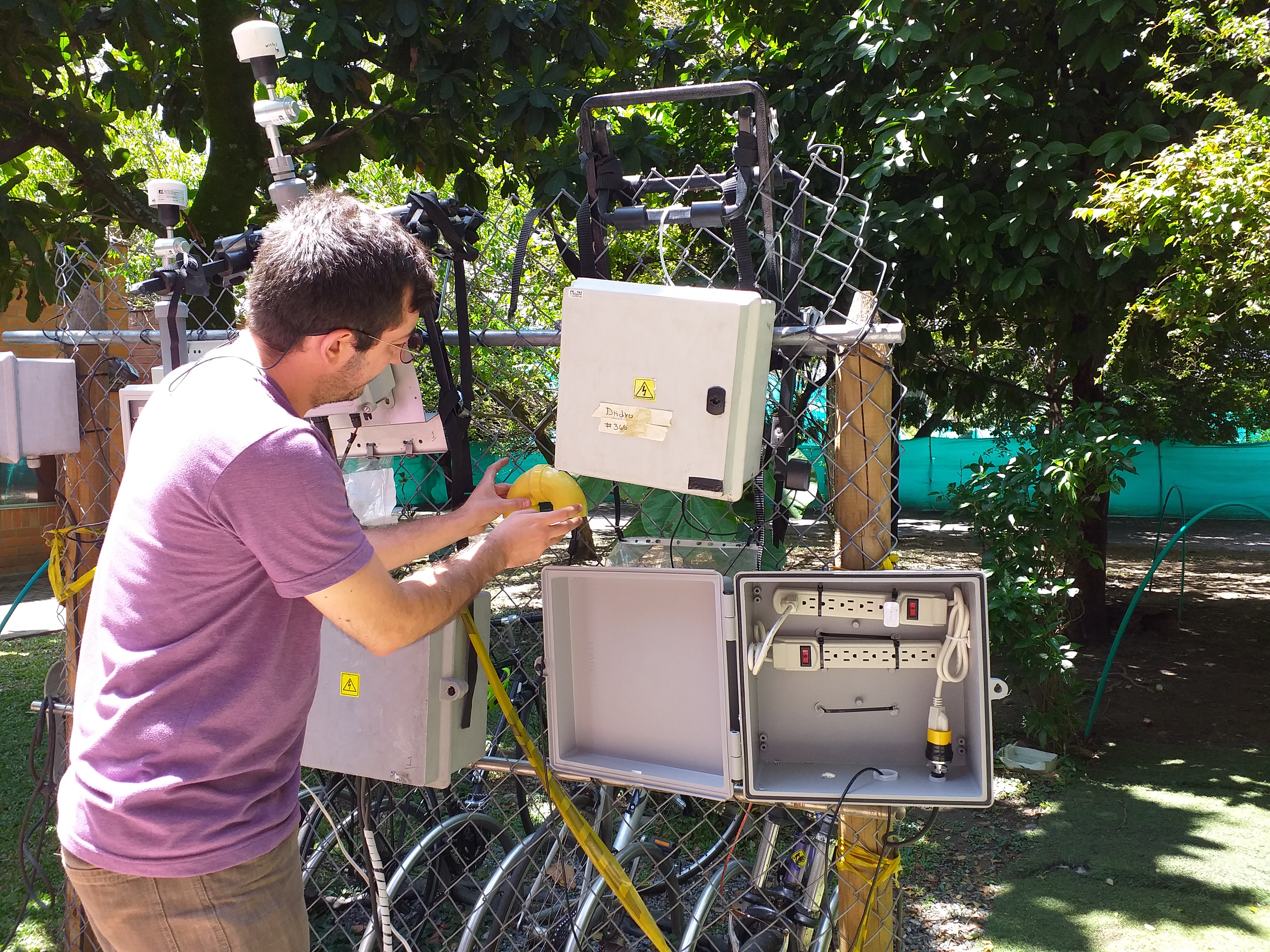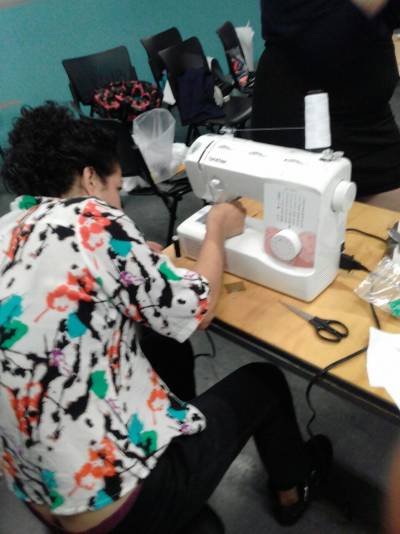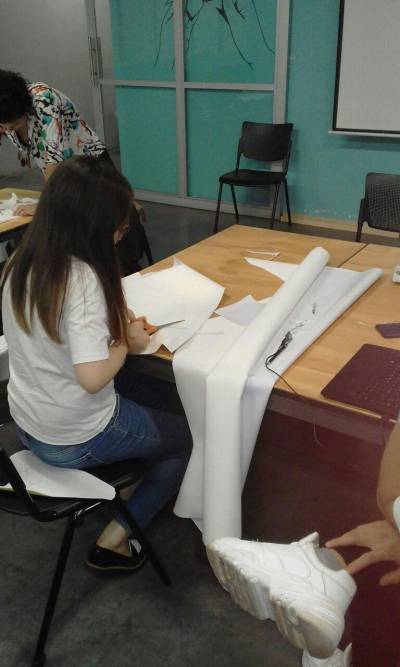proyectos:vestuario_aqa
¡Esta es una revisión vieja del documento!
Tabla de Contenidos
AQA - Taller Vestuario
Prendas de vestuario + AQA
Bitácora
2019-10-17
- Instalación de sensores para proceso de calibración
Referentes
Ideas y materiales que se pueden usar para el taller
prendas
Iluminación
código incial para hacer una animación en la matrix de leds
#include<FastLED.h> #define LED_PIN D3 #define LED_TYPE WS2812B #define COLOR_ORDER GRB #define f false #define t true const uint8_t kMatrixWidth = 8; const uint8_t kMatrixHeight = 8; #define NUM_LEDS (kMatrixWidth * kMatrixHeight) int BRIGHTNESS = 60; // this is half brightness CRGB leds[kMatrixWidth * kMatrixHeight]; #define amarillo CRGB::Yellow #define black CRGB::Black #define rojo CRGB::Red int loop_cnt = 0; uint16_t speed = 20; static uint16_t x; static uint16_t y; static uint16_t z; uint16_t scale = 31; uint8_t noise[kMatrixWidth][kMatrixHeight]; // Fill the x/y array of 8-bit noise values using the inoise8 function. /* void fillnoise8() { for(int i = 0; i < kMatrixWidth; i++) { int ioffset = scale * i; for(int j = 0; j < kMatrixHeight; j++) { int joffset = scale * j; noise[i][j] = inoise8(x + ioffset,y + joffset,z); } } z += speed; } */ void setup() { LEDS.addLeds<LED_TYPE,LED_PIN,COLOR_ORDER>(leds,NUM_LEDS); FastLED.setBrightness(BRIGHTNESS); // Initialize our coordinates to some random values x = random16(); y = random16(); z = random16(); } #define ESCENAS 8 CRGB matrix[ESCENAS][8][8] = { { {CRGB::Green, CRGB::Green, CRGB::Green,CRGB::Green, CRGB::Green, CRGB::Green, CRGB::Green,CRGB::Green}, {CRGB::Green, CRGB::Green, CRGB::Green,CRGB::Green, CRGB::Green, CRGB::Green, CRGB::Green,CRGB::Green}, {CRGB::Green, CRGB::Green, CRGB::Green,CRGB::Green, CRGB::Green, CRGB::Green, CRGB::Green,CRGB::Green}, {CRGB::Green, CRGB::Green, CRGB::Green,CRGB::Green, CRGB::Green, CRGB::Green, CRGB::Green,CRGB::Green}, {CRGB::Green, CRGB::Green, CRGB::Green,CRGB::Green, CRGB::Green, CRGB::Green, CRGB::Green,CRGB::Green}, {CRGB::Green, CRGB::Green, CRGB::Green,CRGB::Green, CRGB::Green, CRGB::Green, CRGB::Green,CRGB::Green}, {CRGB::Green, CRGB::Green, CRGB::Green,CRGB::Green, CRGB::Green, CRGB::Green, CRGB::Green,CRGB::Green}, {CRGB::Green, CRGB::Green, CRGB::Green,CRGB::Green, CRGB::Green, CRGB::Green, CRGB::Green,CRGB::Green}, }, { {CRGB::Green, CRGB::Green, CRGB::Green,CRGB::Green, CRGB::Green, CRGB::Green, CRGB::Green,CRGB::Green}, {CRGB::Green, CRGB::Green, CRGB::Green,CRGB::Green, CRGB::Green, CRGB::Green, CRGB::Green,CRGB::Green}, {CRGB::Green, CRGB::Black, CRGB::Black,CRGB::Black, CRGB::Black, CRGB::Black, CRGB::Black,CRGB::Green}, {CRGB::Green, CRGB::Black, CRGB::Black,CRGB::Black, CRGB::Black, CRGB::Black, CRGB::Black,CRGB::Green}, {CRGB::Green, CRGB::Black, CRGB::Black,CRGB::Black, CRGB::Black, CRGB::Black, CRGB::Black,CRGB::Green}, {CRGB::Green, CRGB::Black, CRGB::Black,CRGB::Black, CRGB::Black, CRGB::Black, CRGB::Black,CRGB::Green}, {CRGB::Green, CRGB::Black, CRGB::Black,CRGB::Black, CRGB::Black, CRGB::Black, CRGB::Black,CRGB::Green}, {CRGB::Green, CRGB::Green, CRGB::Green,CRGB::Green, CRGB::Green, CRGB::Green, CRGB::Green,CRGB::Green}, }, { {CRGB::Green, CRGB::Green, CRGB::Green,CRGB::Green, CRGB::Green, CRGB::Green, CRGB::Green,CRGB::Green}, {CRGB::Green, CRGB::Green, CRGB::Green,CRGB::Green, CRGB::Green, CRGB::Green, CRGB::Green,CRGB::Green}, {CRGB::Green, CRGB::Green, CRGB::Green,CRGB::Green, CRGB::Green, CRGB::Green, CRGB::Green,CRGB::Green}, {CRGB::Green, CRGB::Black, CRGB::Black,CRGB::Black, CRGB::Black, CRGB::Black, CRGB::Black,CRGB::Green}, {CRGB::Green, CRGB::Black, CRGB::Black,CRGB::Black, CRGB::Black, CRGB::Black, CRGB::Black,CRGB::Green}, {CRGB::Green, CRGB::Black, CRGB::Black,CRGB::Black, CRGB::Black, CRGB::Black, CRGB::Black,CRGB::Green}, {CRGB::Green, CRGB::Black, CRGB::Black,CRGB::Black, CRGB::Black, CRGB::Black, CRGB::Black,CRGB::Green}, {CRGB::Green, CRGB::Green, CRGB::Green,CRGB::Green, CRGB::Green, CRGB::Green, CRGB::Green,CRGB::Green}, }, { {CRGB::Green, CRGB::Green, CRGB::Green,CRGB::Green, CRGB::Green, CRGB::Green, CRGB::Green,CRGB::Green}, {CRGB::Green, CRGB::Green, CRGB::Green,CRGB::Green, CRGB::Green, CRGB::Green, CRGB::Green,CRGB::Green}, {CRGB::Green, CRGB::Green, CRGB::Green,CRGB::Green, CRGB::Green, CRGB::Green, CRGB::Green,CRGB::Green}, {CRGB::Green, CRGB::Green, CRGB::Green,CRGB::Green, CRGB::Green, CRGB::Green, CRGB::Green,CRGB::Green}, {CRGB::Green, CRGB::Black, CRGB::Black,CRGB::Black, CRGB::Black, CRGB::Black, CRGB::Black,CRGB::Green}, {CRGB::Green, CRGB::Black, CRGB::Black,CRGB::Black, CRGB::Black, CRGB::Black, CRGB::Black,CRGB::Green}, {CRGB::Green, CRGB::Black, CRGB::Black,CRGB::Black, CRGB::Black, CRGB::Black, CRGB::Black,CRGB::Green}, {CRGB::Green, CRGB::Green, CRGB::Green,CRGB::Green, CRGB::Green, CRGB::Green, CRGB::Green,CRGB::Green}, }, { {CRGB::Green, CRGB::Green, CRGB::Green,CRGB::Green, CRGB::Green, CRGB::Green, CRGB::Green,CRGB::Green}, {CRGB::Green, CRGB::Green, CRGB::Green,CRGB::Green, CRGB::Green, CRGB::Green, CRGB::Green,CRGB::Green}, {CRGB::Green, CRGB::Green, CRGB::Green,CRGB::Green, CRGB::Green, CRGB::Green, CRGB::Green,CRGB::Green}, {CRGB::Green, CRGB::Green, CRGB::Green,CRGB::Green, CRGB::Green, CRGB::Green, CRGB::Green,CRGB::Green}, {CRGB::Green, CRGB::Green, CRGB::Green,CRGB::Green, CRGB::Green, CRGB::Green, CRGB::Green,CRGB::Green}, {CRGB::Green, CRGB::Black, CRGB::Black,CRGB::Black, CRGB::Black, CRGB::Black, CRGB::Black,CRGB::Green}, {CRGB::Green, CRGB::Black, CRGB::Black,CRGB::Black, CRGB::Black, CRGB::Black, CRGB::Black,CRGB::Green}, {CRGB::Green, CRGB::Green, CRGB::Green,CRGB::Green, CRGB::Green, CRGB::Green, CRGB::Green,CRGB::Green}, }, { {CRGB::Green, CRGB::Green, CRGB::Green,CRGB::Green, CRGB::Green, CRGB::Green, CRGB::Green,CRGB::Green}, {CRGB::Green, CRGB::Green, CRGB::Green,CRGB::Green, CRGB::Green, CRGB::Green, CRGB::Green,CRGB::Green}, {CRGB::Green, CRGB::Green, CRGB::Green,CRGB::Green, CRGB::Green, CRGB::Green, CRGB::Green,CRGB::Green}, {CRGB::Green, CRGB::Green, CRGB::Green,CRGB::Green, CRGB::Green, CRGB::Green, CRGB::Green,CRGB::Green}, {CRGB::Green, CRGB::Green, CRGB::Green,CRGB::Green, CRGB::Green, CRGB::Green, CRGB::Green,CRGB::Green}, {CRGB::Green, CRGB::Green, CRGB::Green,CRGB::Green, CRGB::Green, CRGB::Green, CRGB::Green,CRGB::Green}, {CRGB::Green, CRGB::Black, CRGB::Black,CRGB::Black, CRGB::Black, CRGB::Black, CRGB::Black,CRGB::Green}, {CRGB::Green, CRGB::Green, CRGB::Green,CRGB::Green, CRGB::Green, CRGB::Green, CRGB::Green,CRGB::Green}, }, { {CRGB::Green, CRGB::Green, CRGB::Green,CRGB::Green, CRGB::Green, CRGB::Green, CRGB::Green,CRGB::Green}, {CRGB::Green, CRGB::Green, CRGB::Green,CRGB::Green, CRGB::Green, CRGB::Green, CRGB::Green,CRGB::Green}, {CRGB::Green, CRGB::Green, CRGB::Green,CRGB::Green, CRGB::Green, CRGB::Green, CRGB::Green,CRGB::Green}, {CRGB::Green, CRGB::Green, CRGB::Green,CRGB::Green, CRGB::Green, CRGB::Green, CRGB::Green,CRGB::Green}, {CRGB::Green, CRGB::Green, CRGB::Green,CRGB::Green, CRGB::Green, CRGB::Green, CRGB::Green,CRGB::Green}, {CRGB::Green, CRGB::Green, CRGB::Green,CRGB::Green, CRGB::Green, CRGB::Green, CRGB::Green,CRGB::Green}, {CRGB::Green, CRGB::Green, CRGB::Green,CRGB::Green, CRGB::Green, CRGB::Green, CRGB::Green,CRGB::Green}, {CRGB::Green, CRGB::Green, CRGB::Green,CRGB::Green, CRGB::Green, CRGB::Green, CRGB::Green,CRGB::Green}, }, { {CRGB::Black, CRGB::Black, CRGB::Black,CRGB::Black, CRGB::Black, CRGB::Black, CRGB::Black,CRGB::Black}, {CRGB::Black, CRGB::Black, CRGB::Black,CRGB::Black, CRGB::Black, CRGB::Black, CRGB::Black,CRGB::Black}, {CRGB::Black, CRGB::Black, CRGB::Black,CRGB::Black, CRGB::Black, CRGB::Black, CRGB::Black,CRGB::Black}, {CRGB::Black, CRGB::Black, CRGB::Black,CRGB::Black, CRGB::Black, CRGB::Black, CRGB::Black,CRGB::Black}, {CRGB::Black, CRGB::Black, CRGB::Black,CRGB::Black, CRGB::Black, CRGB::Black, CRGB::Black,CRGB::Black}, {CRGB::Black, CRGB::Black, CRGB::Black,CRGB::Black, CRGB::Black, CRGB::Black, CRGB::Black,CRGB::Black}, {CRGB::Black, CRGB::Black, CRGB::Black,CRGB::Black, CRGB::Black, CRGB::Black, CRGB::Black,CRGB::Black}, {CRGB::Black, CRGB::Black, CRGB::Black,CRGB::Black, CRGB::Black, CRGB::Black, CRGB::Black,CRGB::Black}, }, }; void loop() { /*fillnoise8();*/ for(int i = 0; i< kMatrixHeight; i++) { for(int j = 0; j< kMatrixWidth; j++) { leds[i*kMatrixWidth + j] = matrix[loop_cnt%ESCENAS][i][j]; } } FastLED.show(); delay(500); for(int i = 0; i< kMatrixHeight; i++) { for(int j = 0; j<kMatrixWidth; j++) { leds[i*kMatrixWidth + j] = CRGB::Black; } } delay(500); loop_cnt++; }
Algunas fotografias de la 5 sesión del taller
Código para el proyecto del corazon
Este código simula el movimiento del corazón
#include <FastLED.h> FASTLED_USING_NAMESPACE #if defined(FASTLED_VERSION) && (FASTLED_VERSION < 3001000) #warning "Requires FastLED 3.1 or later; check github for latest code." #endif #define DATA_PIN D6 #define CLK_PIN D5 #define LED_TYPE DOTSTAR #define COLOR_ORDER BGR #define NUM_LEDS 23 #define BRIGHTNESS 96 CRGB leds[NUM_LEDS]; int contador = 0; void setup() { FastLED.addLeds<LED_TYPE,DATA_PIN,CLK_PIN,COLOR_ORDER>(leds, NUM_LEDS).setCorrection(TypicalLEDStrip); FastLED.setBrightness(BRIGHTNESS); Serial.begin(115200); } void loop() { contador++; if (contador < 10) { normalHeart(); } else { HeartTired(); } if (contador > 20) { contador = 0; } Serial.println(contador); } void normalHeart() { for(int dot=0; dot<NUM_LEDS+1; dot++) { leds[dot] = CRGB::Green; FastLED.show(); delay(30); leds[dot] = CRGB::Black; FastLED.delay(50); } for(int dot=0; dot<NUM_LEDS+1; dot++) { leds[NUM_LEDS - dot] = CRGB::Green; FastLED.show(); delay(30); leds[NUM_LEDS - dot] = CRGB::Black; FastLED.delay(5); } delay(1000); } void HeartTired() { for(int dot=0; dot<NUM_LEDS+1; dot++) { leds[dot] = CRGB::Red; FastLED.show(); delay(15); leds[dot] = CRGB::Black; FastLED.delay(10); } for(int dot=0; dot<NUM_LEDS+1; dot++) { leds[NUM_LEDS - dot] = CRGB::Red; FastLED.show(); delay(15); leds[NUM_LEDS - dot] = CRGB::Black; FastLED.delay(2); } delay(500); }
Este código usa la libreria FastLed Painter
/** Simple animation demo for using the FastLED painter library This demo does the Knight Rider scanner effect with just a few lines of code The speed and fadespeed need to be adjusted for different processor speeds Chosen settings work nicely on 60-pixels and an Arduino Duemilenove (Uno) */ #define NUMBEROFPIXELS 105 //Number of LEDs on the strip #define PIXELPIN 2 //Pin where WS281X LED strip data-line is connected #include "Arduino.h" #include <FastLED.h> #include <FastLEDPainter.h> #define DATA_PIN D2 #define CLK_PIN D1 #define LED_TYPE DOTSTAR #define COLOR_ORDER BGR #define NUM_LEDS 105 #define BRIGHTNESS 96 CRGB leds[NUM_LEDS]; //create one canvas and one brush with global scope FastLEDPainterCanvas pixelcanvas = FastLEDPainterCanvas(NUM_LEDS); //create canvas, linked to the FastLED library (canvas must be created before the brush) FastLEDPainterBrush pixelbrush = FastLEDPainterBrush(&pixelcanvas); //crete brush, linked to the canvas to paint to void setup() { //initilize FastLED library FastLED.addLeds<LED_TYPE,DATA_PIN,CLK_PIN,COLOR_ORDER>(leds, NUM_LEDS).setCorrection(TypicalLEDStrip); Serial.begin(115200); Serial.println(" "); Serial.println(F("FastLED Painter simple demo")); //check if ram allocation of brushes and canvases was successful (painting will not work if unsuccessful, program should still run though) //this check is optional but helps to check if something does not work, especially on low ram chips like the Arduino Uno if (pixelcanvas.isvalid() == false) Serial.println(F("canvas allocation problem (out of ram, reduce number of pixels)")); else Serial.println(F("canvas allocation ok")); if (pixelbrush.isvalid() == false) Serial.println(F("brush allocation problem")); else Serial.println(F("brush allocation ok")); //initialize the animation, this is where the magic happens: CHSV brushcolor; //the brush and the canvas operate on HSV color space only brushcolor.h = 0; //zero is red in HSV. Library uses 0-255 instead of 0-360 for colors (see https://en.wikipedia.org/wiki/HSL_and_HSV) brushcolor.s = 255; //full color saturation brushcolor.v = 130; //about half the full brightness pixelbrush.setSpeed(1200); //set the brush movement speed (4096 means to move one pixel per update) pixelbrush.setColor(brushcolor); //set the brush color pixelbrush.setFadeSpeed(130); //fading speed of pixels (255 is maximum fading speed) pixelbrush.setFadeout(true); //do brightness fadeout after painting pixelbrush.setBounce(true); //bounce the brush when it reaches the end of the strip //this sets up the brush to paint pixels in red, the pixels fade out after they are painted (the brush is the size of one pixel and can only one pixel per brush update, see other examples to paint multiple pixels at once) } void loop() { FastLED.clear(); //always need to clear the pixels, the canvas' colors will be added to whatever is on the pixels before calling a canvas update pixelbrush.paint(); //paint the brush to the canvas (and update the brush, i.e. move it a little) pixelcanvas.transfer(); //transfer the canvas to the LEDs FastLED.show(); }
Leds con plantower
platformio.ini
;PlatformIO Project Configuration File ; ; Build options: build flags, source filter ; Upload options: custom upload port, speed and extra flags ; Library options: dependencies, extra library storages ; Advanced options: extra scripting ; ; Please visit documentation for the other options and examples ; https://docs.platformio.org/page/projectconf.html [env:d1_mini] platform = espressif8266 board = d1_mini framework = arduino lib_deps = FastLED, PMS Library, https://github.com/DedeHai/FastLEDPainter.git
main.cpp
/** Simple animation demo for using the FastLED painter library This demo does the Knight Rider scanner effect with just a few lines of code The speed and fadespeed need to be adjusted for different processor speeds Chosen settings work nicely on 60-pixels and an Arduino Duemilenove (Uno) */ #include "Arduino.h" #include <SoftwareSerial.h> #include "PMS.h" #include <FastLED.h> #include <FastLEDPainter.h> #define P_TOWER_RX D2 #define P_TOWER_TX 6 // Plantower SoftwareSerial plantower_serial(P_TOWER_RX, P_TOWER_TX); PMS pms(plantower_serial); PMS::DATA data; // Leds #define DATA_PIN D7 #define CLK_PIN D6 #define LED_TYPE DOTSTAR #define COLOR_ORDER BGR #define NUM_LEDS 30 #define BRIGHTNESS 96 CRGB leds[NUM_LEDS]; //create one canvas and one brush with global scope FastLEDPainterCanvas pixelcanvas = FastLEDPainterCanvas(NUM_LEDS); //create canvas, linked to the FastLED library (canvas must be created before the brush) FastLEDPainterBrush pixelbrush = FastLEDPainterBrush(&pixelcanvas); //crete brush, linked to the canvas to paint to CHSV brushcolor; //the brush and the canvas operate on HSV color space only void setup() { //initilize FastLED library FastLED.addLeds<LED_TYPE,DATA_PIN,CLK_PIN,COLOR_ORDER>(leds, NUM_LEDS).setCorrection(TypicalLEDStrip); plantower_serial.begin(9600); Serial.begin(115200); Serial.println(" "); Serial.println(F("FastLED Painter simple demo")); //check if ram allocation of brushes and canvases was successful (painting will not work if unsuccessful, program should still run though) //this check is optional but helps to check if something does not work, especially on low ram chips like the Arduino Uno if (pixelcanvas.isvalid() == false) Serial.println(F("canvas allocation problem (out of ram, reduce number of pixels)")); else Serial.println(F("canvas allocation ok")); if (pixelbrush.isvalid() == false) Serial.println(F("brush allocation problem")); else Serial.println(F("brush allocation ok")); //initialize the animation, this is where the magic happens: brushcolor.h = 0; //zero is red in HSV. Library uses 0-255 instead of 0-360 for colors (see https://en.wikipedia.org/wiki/HSL_and_HSV) brushcolor.s = 255; //full color saturation brushcolor.v = 130; //about half the full brightness pixelbrush.setSpeed(1200); //set the brush movement speed (4096 means to move one pixel per update) pixelbrush.setColor(brushcolor); //set the brush color pixelbrush.setFadeSpeed(130); //fading speed of pixels (255 is maximum fading speed) pixelbrush.setFadeout(true); //do brightness fadeout after painting pixelbrush.setBounce(true); //bounce the brush when it reaches the end of the strip //this sets up the brush to paint pixels in red, the pixels fade out after they are painted (the brush is the size of one pixel and can only one pixel per brush update, see other examples to paint multiple pixels at once) } void loop() { Serial.println("Leyendo sensor"); if (pms.readUntil(data)){ Serial.print("PM2.5 ");Serial.println(data.PM_AE_UG_2_5); // brushcolor.h = data.PM_AE_UG_2_5; // pixelbrush.setColor(brushcolor); // // pixelbrush.setFadeSpeed(data.PM_AE_UG_2_5*3); Serial.print("PM10 ");Serial.println(data.PM_AE_UG_10_0); // saveDataForAverage(data.PM_AE_UG_2_5,data.PM_AE_UG_10_0); } else Serial.println("ERROR leyendo sensor"); Serial.println("Encendiendo leds"); FastLED.clear(); //always need to clear the pixels, the canvas' colors will be added to whatever is on the pixels before calling a canvas update pixelbrush.paint(); //paint the brush to the canvas (and update the brush, i.e. move it a little) pixelcanvas.transfer(); //transfer the canvas to the LEDs FastLED.show(); }
Leds + plantower: cambia color segun lectura del sensor
platformio.ini
[env:d1_mini] platform = espressif8266 board = d1_mini framework = arduino lib_deps = FastLED, PMS Library, https://github.com/DedeHai/FastLEDPainter.git, Time
main.cpp
#include "Arduino.h"
#include <SoftwareSerial.h>
#include "PMS.h"
#include <FastLED.h>
#include <FastLEDPainter.h>
#include <Time.h>
#define P_TOWER_RX D2
#define P_TOWER_TX 6
// Plantower
SoftwareSerial plantower_serial(P_TOWER_RX, P_TOWER_TX);
PMS pms(plantower_serial);
PMS::DATA data;
int pm2_5 = 0;
int *dir_pm2_5;
// Leds
#define DATA_PIN D7
#define CLK_PIN D6
#define LED_TYPE DOTSTAR
#define COLOR_ORDER BGR
#define NUM_LEDS 26 // estos 10 es para que cuando lea el sensor no se vean los leds prendidos
#define BRIGHTNESS 96
CRGB leds[NUM_LEDS];
//create one canvas and one brush with global scope
FastLEDPainterCanvas pixelcanvas = FastLEDPainterCanvas(NUM_LEDS); //create canvas, linked to the FastLED library (canvas must be created before the brush)
FastLEDPainterBrush pixelbrush = FastLEDPainterBrush(&pixelcanvas); //crete brush, linked to the canvas to paint to
CHSV brushcolor; //the brush and the canvas operate on HSV color space only
int color = 0;
int speed = 400;
int time_hours = 0;
int time_minutes = 0;
int time_seconds = 0;
void readPlantower();
void animateLeds();
void updateValues();
void setup() {
//initilize FastLED library
FastLED.addLeds<LED_TYPE, DATA_PIN, CLK_PIN, COLOR_ORDER>(leds, NUM_LEDS).setCorrection(TypicalLEDStrip);
plantower_serial.begin(9600);
Serial.begin(115200);
Serial.println(" ");
Serial.println(F("FastLED Painter simple demo"));
//check if ram allocation of brushes and canvases was successful (painting will not work if unsuccessful, program should still run though)
//this check is optional but helps to check if something does not work, especially on low ram chips like the Arduino Uno
if (pixelcanvas.isvalid() == false)
Serial.println(F("canvas allocation problem (out of ram, reduce number of pixels)"));
else
Serial.println(F("canvas allocation ok"));
if (pixelbrush.isvalid() == false)
Serial.println(F("brush allocation problem"));
else
Serial.println(F("brush allocation ok"));
//initialize the animation, this is where the magic happens:
brushcolor.h = color; //zero is red in HSV. Library uses 0-255 instead of 0-360 for colors (see https://en.wikipedia.org/wiki/HSL_and_HSV)
brushcolor.s = 255; //full color saturation
brushcolor.v = 130; //about half the full brightness
pixelbrush.setSpeed(speed); //set the brush movement speed (4096 means to move one pixel per update)
pixelbrush.setColor(brushcolor); //set the brush color
pixelbrush.setFadeSpeed(130); //fading speed of pixels (255 is maximum fading speed)
pixelbrush.setFadeout(true); //do brightness fadeout after painting
pixelbrush.setBounce(true); //bounce the brush when it reaches the end of the strip
// set pointer
dir_pm2_5 = &pm2_5;
// setup time
setTime(time_hours, time_minutes, time_seconds, 30, 11, 19);
}
void loop() {
readPlantower();
}
void readPlantower() {
int sec = second();
if (sec == 0 || sec == 15 || sec == 20 || sec == 30 || sec == 40 || sec == 50 ||
sec == 5 || sec == 10 || sec == 35 || sec == 35 || sec == 45 || sec == 55) {
pms.wakeUp();
if (pms.read(data)) {
pm2_5 = data.PM_AE_UG_2_5;
delay(500);
updateValues();
}
Serial.print("Leyendo pm 2.5 ");
Serial.println(*dir_pm2_5);
}
else {
Serial.print("durmiendo. Ultimo valor ");
Serial.println(*dir_pm2_5);
pms.sleep();
animateLeds();
}
// Serial.print("sec: ");
// Serial.println(sec);
}
void animateLeds(){
// Serial.println("Encendiendo leds");
FastLED.clear(); //always need to clear the pixels, the canvas' colors will be added to whatever is on the pixels before calling a canvas update
pixelbrush.paint(); //paint the brush to the canvas (and update the brush, i.e. move it a little)
pixelcanvas.transfer(); //transfer the canvas to the LEDs
FastLED.show();
}
void updateValues() {
// varia en los que varia
/*
233 minimo
1225 maximo
*/
if (*dir_pm2_5 < 400){
brushcolor.h = 90; // aire bueno verde
pixelbrush.setColor(brushcolor);
pixelbrush.setFadeout(true);
pixelbrush.setBounce(true);
} else if (*dir_pm2_5 > 400 ) {
brushcolor.h = 200; // aire regular azul
pixelbrush.setColor(brushcolor);
pixelbrush.setFadeout(true);
pixelbrush.setBounce(true);
} else if (*dir_pm2_5 > 800) {
brushcolor.h = 155; // aire malo ?
pixelbrush.setColor(brushcolor);
pixelbrush.setFadeout(true);
pixelbrush.setBounce(true);
} else if (*dir_pm2_5 > 1200) {
brushcolor.h = 0; // magenta aire podrido
pixelbrush.setColor(brushcolor);
pixelbrush.setFadeout(true);
pixelbrush.setBounce(true);
}
}
proyectos/vestuario_aqa.1575612256.txt.gz · Última modificación: por kz


